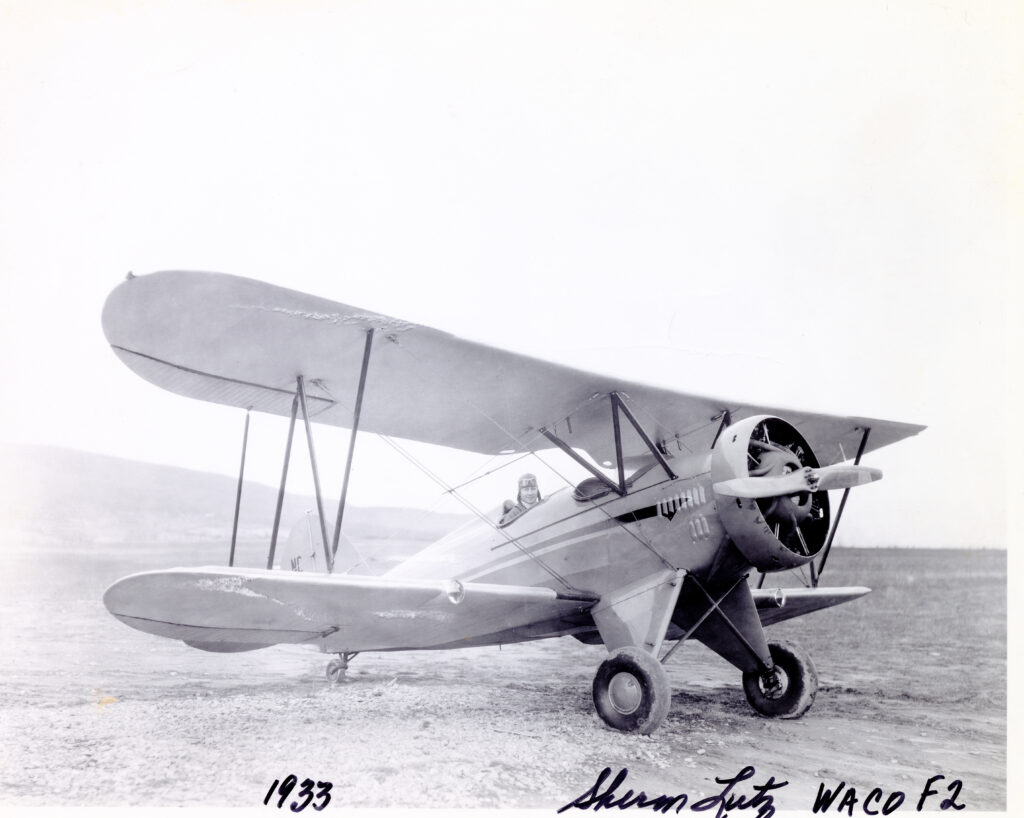Sherman Lutz was an aviator, flight instructor, and advocate of commercial flight in Centre County.
Born in 1903 and raised on a dairy farm in Fillmore, Lutz learned to fly as a teenager in a biplane owned by a Pleasant Gap automobile mechanic, Henry Noll. After stints as a barnstormer and as an airplane mechanics instructor in Harrisburg, Lutz returned to Centre County.
In 1932, he built an airport in Boalsburg just north of the Pennsylvania Military Museum and near the present site of St. Joseph’s Catholic Academy. He flew charters, towed banners, and provided fuel and maintenance for other aircraft. But his airport was primarily a flight school. During his career as an instructor, Lutz supervised the first solo flights of 476 pilots.

With the approach of World War II, Lutz contributed to the national effort to accelerate the training of pilots. He was an instructor for the Civilian Pilot Training Program (CPTP), created in 1938 as a government-sponsored collaboration with select colleges and universities, including Penn State. Lutz and his instructors trained about 270 CPTP pilots after the U.S. entered the war in 1941.
Lutz taught dozens of young women to fly, including Penn State students who took part in a program sponsored by the Civil Aeronautics Administration (CAA) from 1939 to 1941. Janet Twichell, one of the CAA pilot cadets, soloed in 1940 and later served in the Women’s Army Corps.
In 1940, Lutz’s plane crashed near the Centre Hills Country Club while he was giving lessons to a teenage student, Charles Neyhart of State College. Both Lutz and Neyhart were hospitalized for months. After inspecting the wreckage and interviewing Lutz, federal investigators concluded that a design flaw in the airplane’s control system had triggered the crash. Sixteen pilots had died in previous crashes of that model. Neyhart credited the two men’s survival to Lutz’s skill and composure.
Listen to “Dead Centre” podcast about Sherman Lutz
Like his instructor, Neyhart returned to flying soon after he recovered from the crash. He served as a pilot in World War II, the Korean War, and the Vietnam War.
Some of Lutz’s students became pilots in the airline industry as it grew rapidly in the mid-20th century. One of these, Al Reeser, was a Penn State student from the Lancaster area who soloed in 1938. After flying for the Air Transport Command in World War II, he flew for Eastern Airlines and American Airlines, where he became an assistant vice president.
An early advocate for commercial air transportation to and from State College, Lutz moved his operations from Boalsburg. In 1946 he built a larger airfield, the State College Air Depot, in the Pine Hall area about three miles west of downtown State College. After extensive grading to create a smooth grass runway, the depot hosted Centre County’s first commercial passenger service.
From 1949 to 1951, All-American Airlines provided scheduled service with 24-seat DC-3s. However, Lutz’s resistance to making additional improvements – such as longer landing strips, paved runways and lighting for night flights – prompted the airline to move its commuter service to the Black Moshannon Airport (later known as the Mid-State Regional Airport) in Philipsburg where it operated from 1952 to 1987. In 1953, it became Allegheny Airlines.
The State College Borough Council considered buying the depot from Lutz and expanding it into a municipal airport. But opposition from residents who lived near the airport and from parents whose children attended the nearby Corl Street Elementary School forced the council to abandon the plan.
Lutz continued to fly charters and give flight instruction at the depot, but it declined in importance after 1957 when the State College Airport Authority recommended a site north of the borough on land owned by Penn State as the location of a new airport. Lutz closed the depot in 1987.
Later that year, University Park Airport, which had become Centre County’s regional airport, held “Sherm Lutz Day.” His former students praised him for the rigorous training he provided, the confidence he instilled, and the opportunities he gave to young people who shared his love of flying. Lutz died in State College in 1998 at the age of 94.
Katie O’Toole
Sources:
Bergstein, Elizabeth. “Solo.” Town & Gown, Volume 22, Issue 12, December 1987, pp. 10-20, 25-30.
Truby, David J. “The Lutz Story Parallels Growth of Aviation,” Centre Daily Times, November 19, 1969.
First Published: June 10, 2021
Last Modified: April 22, 2022
